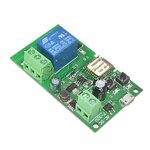Rebelrebel
Newbie level 4

Greeting everyone,
I am in a rental property with a simple on-off heater controller. Due to the extreme climate, the house can cool down to 10 degrees when I get home from work. I have been considering hacking the switch to attach a simple relay (WIFI) so I can put it on a timer.
My electronics experience is very limited to quadcopter building. I can solder without issues.
I have tested if I short the top and bottom pins of the switch on the left, the heater turns on.

Can I use this device to use wifi to switch my heater on off?

https://www.ebay.com.au/itm/Self-lo...557405?hash=item2cc2ba689d:g:4H0AAOSwhilZZcXh
Due to being a rental, I can't really change my heating system/drill holes in the wall etc and want to keep the budget to the minimum.
Any hints, tips or links to reading material for my education is much appreciated.
Thanks for reading!
I am in a rental property with a simple on-off heater controller. Due to the extreme climate, the house can cool down to 10 degrees when I get home from work. I have been considering hacking the switch to attach a simple relay (WIFI) so I can put it on a timer.
My electronics experience is very limited to quadcopter building. I can solder without issues.
I have tested if I short the top and bottom pins of the switch on the left, the heater turns on.

Can I use this device to use wifi to switch my heater on off?

https://www.ebay.com.au/itm/Self-lo...557405?hash=item2cc2ba689d:g:4H0AAOSwhilZZcXh
Due to being a rental, I can't really change my heating system/drill holes in the wall etc and want to keep the budget to the minimum.
Any hints, tips or links to reading material for my education is much appreciated.
Thanks for reading!
Last edited by a moderator:


